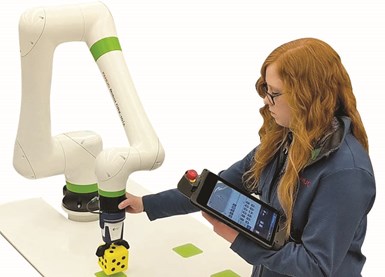Working Smarter, Not Harder
Geoff Dawson from PMPA member FANUC America talks about their history, how robots have enhanced the workspace and about their latest automation family.
#pmpa
PMPA: What is a brief history of FANUC America?
Geoff Dawson: FANUC Robotics was established in 1982 as a joint venture between General Motors and FANUC Corporation of Japan. In the early 1990s, FANUC Robotics became a wholly owned subsidiary of FANUC. In 2013, FANUC CNC and FANUC Robotics merged and became FANUC America Corporation. The company has three product families: robotics, Robomachines and CNC controls, and motors and motion platforms.
Featured Content
PMPA: How does FANUC serve the machine industry?
GD: Our focus for the machining industry is on automation and small machines that can serve high mix/low volume. High mix/low volume has always been there, but we are seeing a larger need. Our Robodrill (automated machining for more versatile milling, drilling and tapping) and Robonano (high precision and high accuracy) benefit the industry. And our controls too — 50% or more of the world’s machines have FANUC controls on them.
PMPA: How have you seen robots and automation affect the workforce?
GD: Today, robots and automation allow employees to run the equipment instead of doing the process by hand. The robots can do the dull and dirty jobs, while skilled employees manage the automation. For example, rather than actually doing the machine load/unload, an employee can operate several stations. Owners are looking at the efficiency pickup by putting automation in front of a machine, improving their spindle utilization and then giving the workforce a higher value job.
FANUC is focused on helping to create a skilled workforce through our certified education program where we work with colleges and high schools. Currently, FANUC works with over 1,000 educational institutions throughout the Americas, and that number is growing at a fast pace.
PMPA: What is the CRX robot family?

An operator teaches the CRX Collaborative Robot by guiding it manually.
GD: The CRX robot is our latest collaborative robot designed to make installing and programming robots easier than ever before. We have been offering collaborative robots for about six years. Collaborative robots move a little slower and have power and force limited safeguards in place so they can work side-by-side with a person. If the robots contact or run into something, they stop.
The real focus is ease-of-use. If there is a group of CNC operators, but they have never touched a robot, we want to make it as easy as possible for them to use a robot without having to know programming. Our CRX is a drag-and-drop program on the interface — when the operator wants to teach a point, it can be dragged and dropped on the time line. But they can also teach the robot by moving it to the position they want. We wanted to find a way to help smaller companies overcome any challenges related to integrating robots and automation. The CRX robot family is affordable and easy to integrate and use – all key factors for small shops looking to increase their competitive position in the market.
PMPA: What is QSSR?
GD: QSSR stands for Quick and Simple Startup to Robotization. That’s an interface to make it simple to connect a FANUC robot to a Robodrill or any FANUC CNC machine. It’s plug-and-play. The whole idea is to make it easy to use and easy-to-own for life.
PMPA: How does FANUC make it easy to own?
GD: We have a mantra that comes from the top and it’s “service first.” We service products for life — we don’t obsolete anything. As long as the owner has use for the machine, we will service it. It is really great to be part of a company that feels that way.
PMPA: Why do you value your PMPA membership?
GD: Our membership allows us to keep up with industry trends and better understand what our customers want and need. Our goal is to help people solve their problems and PMPA allows us to do that. It makes us a better company.
RELATED CONTENT
-
Handling Parts In A Robotic Cell
Here’s a review of the workholding and workhandling challenges a shop faces as it moves a part through a robotic cell, from serving up the blanks to the transfer of the final workpiece to post processing and gaging. Productivity, Inc. takes the reader through a few of their cells that they've installed using Fanuc robots and a variety of other machine tool equipment.
-
Checklist for Lights-Out Manufacturing
Many shops of various sizes are trying to hop on the lights-out bandwagon. This article looks at some things to consider and check out before “hopping.”
-
What Is The Best Bar Feed System For Production Turning?
Selecting the right bar feeder can be one of the most important decisions a shop can make. Bar feed systems help improve productivity, throughput and quality, but in order to achieve the most benefit from them it is essential that a bar feed system be matched to the particular needs of the turning operation.
.png;maxWidth=970;quality=90)




